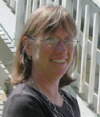 |
|
|
| SEARCH | ENGAGING SCIENTISTS: MARY JANE PERRY | |||||||||||||||||||||||||||||||||||||||||||||||||||||||||||||
|
 One of COSEE's main goals is assisting scientists in the development of meaningful, high-impact methods for sharing their knowledge. Scientists Making an Impact is an online case-study project that presents in-depth studies of 13 COSEE scientists and is designed to help early-career scientists understand the collaborations needed, challenges faced and rewards reaped from partaking in educational activities along with the pursuit of research. Mary Jane Perry - Pioneering Collaborator
Because of the complex nature and breadth of the NAB experiment, the webinar series -- archived online for long-term access -- offers meaningful linkages to most of the "cross-cutting scientific concepts" outlined in the New Framework of the National Science Education Standards. Accompanying each webinar archive is a dataset activity, co-developed by NAB scientists, for use in Science, Technology, Engineering and Math (STEM) courses.
NAB Science
Over the course of three cruises, a float, four sea gliders and instruments on two research vessels were used to sample the initiation, growth and demise of the 2008 North Atlantic spring bloom. Measurements from autonomous sensors, as well as more traditional ship-based measurements, were used to get a fuller understanding of the processes involved in the bloom. Viewpoints
Seven participating scientists were interviewed after the webinar series to reflect on their experiences, including what
they learned during the process. The full case study (containing interview footage, interactive concept maps and other
resources) is scheduled to be published on the Engaging Scientists website in late July.
Concept Maps
Each webinar presenter worked to create an interactive concept map loaded with educational resources. Below are the concept maps from
each individual webinar, which can be viewed in detail by clicking on the image of the map.
Map #1: Introduction to the North Atlantic Bloom - Mary Jane Perry Map #2: What Triggers the Bloom? - Amala Mahadevan Map #3: Measuring the Bloom - Eric D'Asaro Map #4: Marine Food Web and Carbon Cycling - Nicole Poulton & Ivona Cetinic Map #5: Broader Implications - Craig Lee Resources
North Atlantic Bloom Experiment WebpageNorth Atlantic Bloom Webinar Archive Pages COSEE-OS Webinar Homepage |
|
|||||||||||||||||














